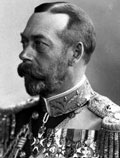 |
George V
b. 3 Jun 1865, London
d. 20 Jan 1936, Sandringham House near King's Lynn, Norfolk |
| Title: |
By the Grace of God of the United Kingdom of Great Britain and Ireland and of the British Dominions beyond the Seas King, Defender of the Faith, Emperor of India (Dei Gratia Britanniarum et terrarum transmarinarum quae in ditione sunt Britannica Rex, Fidei Defensor, Indiae Imperator) [6 May 1910 - 13 May 1927] |
|
By the Grace of God of Great Britain, Ireland and the British Dominions beyond the Seas King, Defender of the Faith, Emperor of India (Dei Gratia Magnae Britanniae, Hiberniae et terrarum transmarinarum quae in ditione sunt Britannica Rex, Fidei Defensor, Indiae Imperator) [13 May 1927 - 20 Jan 1936] |
| Term: |
6 May 1910 - 20 Jan 1936 |
| Chronology: |
6 May 1910, succeeded his father, Edward VII |
|
22 Jun 1911, crowned, Westminster Abbey |
|
13 May 1927, royal style changed by Order in Council approving Proclamation altering the Style and Titles appertaining to the Crown issued under the authority of the Royal and Parliamentary Titles Act , 1927 (Statutory Rules and Orders, 1927/422; The London Gazette, No. 33274, May 13, 1927, p. 3111) |
|
20 Jan 1936, died |
| Names/titles: |
Private name: George Frederick Ernest Albert [to 17 Jul 1917], George Frederick Ernest Albert Windsor [from 17 Jul 1917]; Duke of York, Earl of Inverness, Baron Killarney [from 24 May 1892]; Duke of Cornwall and Duke of Rothesay, Earl of Carrick, Baron Renfrew, Lord of the Isles, Great Steward of Scotland [from 22 Jan 1901]; Prince of Wales, Earl of Chester [from 9 Nov 1901]; family and dynastic name Windsor established by the Royal Proclamation of 17 Jul 1917 |
| Biography: |
George Frederick Ernest Albert was the second son of Albert Edward Prince of Wales (later King Edward VII). He entered the British navy in 1877 and gradually rose to the rank of vice admiral in 1903. George became the second in the line of succession following the death of his elder brother, Prince Albert Victor Duke of Clarence (14 Jan 1892). Created Prince of Wales after his father's accession (1901), he succeeded him on 6 May 1910 as King George V. The accession of George V coincided with the constitutional crisis over the House of Lords, which refused to pass a Parliament Bill limiting its powers. After the Liberal government of Herbert Henry Asquith obtained the King's promise to create sufficient peers to overcome Conservative opposition in the Lords, the Parliament Bill was enacted in 1911. The autonomy for Ireland within the British Empire was granted by the Irish Home Rule Act (18 Sep 1914), but it was suspended because of the outbreak of World War I. During the war, George V visited the British troops in France earning respect among his subjects. Nationalist feeling led George V to adopt the family name of Windsor and to renounce all the German titles belonging to him and his family by the royal proclamation of 17 Jul 1917. Following the Easter Rising in Dublin (1916), Britain became involved in a civil war in Ireland. In 1921 George V opened the Parliament of Northern Ireland in Belfast created in accordance with the Government of Ireland Act (1920). The peace negotiations resulted in the creation of the Irish Free State (6 Dec 1922), formally headed by the British sovereign. George was the first British king to accept the first Labour government of Ramsay MacDonald in 1924. The Imperial Conferences held in London in 1926 and 1930 granted full autonomy within the British Empire to all British dominions. The Statute of Westminster, enacted by the Parliament in December 1931, legally implemented these decisions. |
|
|
| |
| [1] |
Fryde, E.B., et al. (eds.) Handbook of British Chronology. London: Offices of the Royal Historical Society: University College, 1986. 3rd edition. online |

